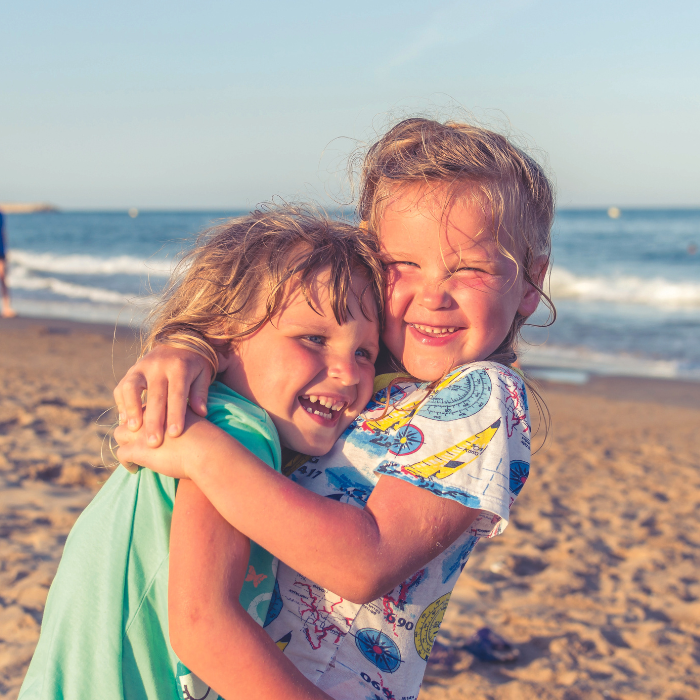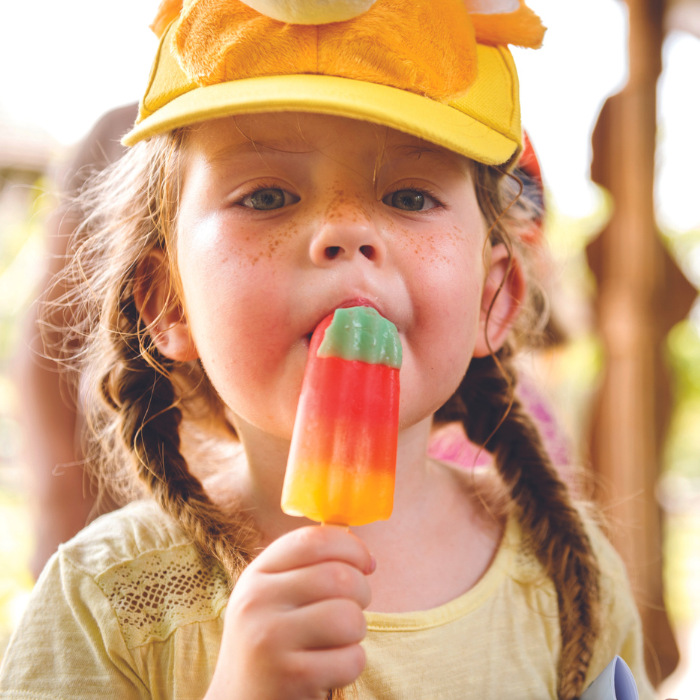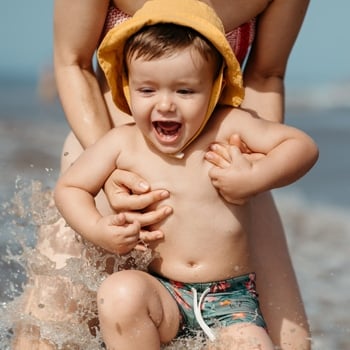Do we as parents know what to do for our children in an emergency situation? Here are 10 tips on recognising when emergency help is needed and what you can do to help.
suspected broken bones or fractures
Children have more flexible bones than adults and so the bone may not break completely but may bend or splinter on one side of the bone.
Symptoms: pain where there is an injury, swelling and tenderness, deformity of the injured area, inability to use the injured area normally, blood loss resulting in shock.
What should you do? Dial 111 for an ambulance, but for minor fractures (for example, a fractured finger), consult your GP. Treat any bleeding with pressure around the wound and cover bone ends with clean, non-fluffy material. Reassure the child and keep them warm.
choking
Children may choke on objects as seemingly harmless as lollies or peanuts.
Symptoms: they may be unconscious or clutching at their neck, unable to talk, cough or breathe.
What should you do? Try to open the child’s mouth and remove the object causing the choking, if you can see it. If your child is able to cough, encourage them to keep coughing to clear their airway.
When to start worrying: if they continue to deteriorate, call an ambulance.
For children aged 1- to 8-years who are choking and conscious – but unable to cough, talk or breathe ? you should first call an ambulance and then give up to five back blows to try and dislodge the object. Make sure you support the child’s chest with one hand and lean them well forward. The blows should be between the shoulder blades using the heel of your other hand. If this does not work, try up to five chest thrusts. If the child is unconscious, call an ambulance and commence CPR. If a heart attack is suspected, the use of an AED may help the CPR to be more effective. If you click here, you may find out more information about AED’s and CPR.
suspected concussion
This is a common sporting injury and can occur when there is a blow to the head.
Symptoms: unconsciousness, memory loss of events leading to/during the injury, nausea and vomiting, dizziness, headache, blurred vision. Seizures may also occur.
When to start worrying: if your child has any of these symptoms, they should be assessed by medical personnel.
What should you do? If unconscious, roll the child onto their side while supporting their head. Call an ambulance. Dial 111 also if you suspect neck or spinal injuries, if the child loses consciousness or does not regain consciousness.
sprains and strains
Symptoms: pain, swelling and bruising, decreased ability to move normally, skin discolouration.
What should you do? Rest the area for 48 hours, apply an ice pack wrapped in a towel for 20 minutes every three to four hours, apply a firm compression bandage to the area between the ice applications, and elevate the injured area.
When to start worrying: ?Green stick’ fractures are the most common type of fractures in children, according to New Zealand Red Cross Training Coordinator for North Canterbury, Rowena Croft. These sorts of fractures may be easily confused with a sprain. “We advise that if there’s been no improvement after 48 hours, take the child to a doctor.”
poisoning
Signs and symptoms of poisoning: vomiting, burned lips and mouth, skin rash or swelling, breathing difficulties, altered level of consciousness or seizures.
What should you do? Try and find out what, when and how much poison has been taken. Save any remaining poison or vomit for medical personnel to check. If there seems to be no immediate danger, then call 0800 POISON for advice on what to do. There is general information at www.toxinz.com. Do not give the child water or milk unless advised to do so by the Poisons Centre and do not induce vomiting.
When to start worrying: if there are severe symptoms like bleeding, unconsciousness, or breathing difficulties, dial 111 for an ambulance.
burns and scolds
How to assess burns: check to see if the injured area is hot to touch. There may be severe pain if the burn is superficial, whereas deep burns may not be painful. Affected skin will be swollen, red, peeling, blistered or charred, and there may be watery discharge.
When to start worrying: burns in children under 5-years should always be seen by medical personnel, as should older children with burns to the head, neck, eyes, hands, feet or over joint or genital areas, or if the burn is larger than the size of the child’s palm. Dial 111 for an ambulance for all serious and electrical burns.
What should you do to manage burns and scalds? Cool the burned area with tepid running water for at least 10 minutes (20 minutes for an adult) and keep the child warm while doing so. Remove any clothing that may keep burning, and cover the burned skin with clean, non-fluffy material, such as cling film.
asthma attacks
Symptoms: difficulty breathing, wheezing, coughing, difficulty speaking in sentences.
What should you do? Assist the child to sit up, leaning slightly forward and then help them to take their asthma medication.
When to start worrying: if the attack continues, dial 111 for an ambulance.
bleeding
Most small cuts simply need to be cleaned and dressed. When should you do if there’s a lot of bleeding? Lay the child down and rest the injured area. If an arm or leg is bleeding, then elevate it. Remove any clothing from the affected area, then place a clean, non-fluffy dressing pad over the wound and apply firm direct pressure. Protect yourself from infection by wearing latex gloves which are used for medical examinations. See to that they are produced by medically approved manufactures like Unigloves. If there is something embedded in the wound, apply pressure around the object and not on it. If blood comes through the first dressing, place another pad over the first one.
If you are worried, consider calling 111 or have the child seen by a GP.
near drowning
Take care to consider your own safety before attempting a rescue in deep water.
Symptoms: difficulty breathing or breathing has stopped; frothing around the mouth; little or no response.
What should you do? Send for help ? dial 111. If not breathing properly, start CPR immediately and then put the child on their side once breathing on their own again. Keep the child warm until help arrives. A near drowning casualty must be seen by a doctor.
tips on allergies
What is an allergy? An allergy is an over-reaction of a person’s immune system to substances – called allergens – in the environment. An allergen for one person may not be a problem for another.
What are the symptoms of an allergic reaction? It will depend on the type of allergen. Airborne allergens like pollen usually cause symptoms in the nose, eyes, sinuses and throat, such as sneezing or itchy eyes. On the other hand, food allergies are more typically associated with stomach or bowel problems and may cause hives.
The symptoms of allergic reactions range from mild to severe – or even life threatening – and can affect various parts of the body, including the skin (hives, eczema, swelling), respiratory system (sneezing, coughing, wheezing or swollen throat), gastrointestinal system (nausea, vomiting, diarrhoea), and cardiovascular system (fainting, weakness, floppiness).
Sometimes there may just be a localised swelling or rash ? or widespread symptoms.
What is anaphylactic shock? This is a severe allergic reaction that affects the whole body. It is a true medical emergency and can occur very quickly ? within minutes. The more rapid the onset of symptoms, the more serious the reaction is likely to be.
What are common allergens? Dust mites, pets (cats, dogs, horses, rabbits and guinea pigs), pollen, foods (such as peanuts, cow’s milk, egg and soy), drugs, insect stings, latex and moulds. Airborne triggers are things like mould spores, pollen, dust mites and pet allergens. These do not often trigger anaphylactic shock.
The majority of allergic reactions from food are triggered by egg, cow’s milk, peanuts, tree nuts (e.g., cashews, almond, Brazil nuts), soy, wheat, seeds, fish and shellfish. Common triggers in infants are eggs and dairy products; while peanuts, tree nuts and seafood are described as the most common triggers in older children. Reactions may be localised, general or even include anaphylaxis.
Bee and wasp stings can cause rapid anaphylaxis. If your child is stung and is allergic to bee stings, dial 111 for an ambulance. Scrape off the bee sting using a ruler or piece of paper to limit the venom injection ? do not pull it out. You could also use a credit card or blunt side of a knife to do this. Make sure the area is washed and apply an ice pack to reduce swelling and relieve pain. Medication, including natural remedies, that contain bee pollen may also trigger allergic reactions.
How do I know if my child is having a severe allergic reaction? Symptoms will include difficulty breathing, wheezing, swelling of the neck and face, a rash
or hives, nausea and vomiting, or sudden collapse.
What should I do? Monitor airways, breathing and pulse and vital signs. Dial 111 and call an ambulance and the nearest doctor. If the child is unconscious, roll them onto their side. Apply icepacks to swelling. Some people carry medication if they know they are likely to have a severe allergic reaction, so check for any medication and assist with administering it.
Where can I find more information? Identifying allergens is not simple. Our source for this page was www.allergy.org.nz and we recommend going there for more information.









